
- Homepage
- Author
- Aleister Crowley (6)
- Arthur Von Mayer (15)
- Bram Stoker (8)
- Charles Dickens (9)
- Dan Brown (7)
- Dr. Seuss (18)
- Ernest Hemingway (9)
- Frank Herbert (9)
- George Orwell (12)
- Howe, George (6)
- J.k. Rowling (44)
- J.r.r. Tolkien (16)
- Kurban Said (6)
- L. Frank Baum (9)
- Margaret Mitchell (8)
- Mark Twain (8)
- Robert Paul Smith (6)
- Rudyard Kipling (16)
- Stephen King (28)
- Wendell Berry (9)
- Other (2639)
- Binding
- Brand
- Bandai (6)
- Bratz (16)
- Coomodel (5)
- Dc Collectibles (3)
- Disney (3)
- Fire Toys (2)
- Hasbro (6)
- Hot Toys (15)
- Kenner (5)
- Mattel (7)
- Mcfarlane Toys (3)
- Mezco (3)
- Neca (3)
- No Brand (22)
- Pokemon Game (2)
- Random House (4)
- Super Duck (3)
- Tiger Electronics (2)
- Vintage Bookworms (3)
- Wizards Of The Coast (13)
- Other (2762)
- Language
- Publisher
- Alfred A. Knopf (31)
- Bloomsbury (22)
- Doubleday (32)
- Dutton (9)
- Easton Press (19)
- Franklin Library (11)
- G.p. Putnam's Sons (9)
- Grosset & Dunlap (11)
- Harcourt Brace (11)
- Harper & Brothers (20)
- Harper & Row (16)
- Jonathan Cape (12)
- Macmillan (22)
- Marvel Comics (10)
- Random House (54)
- Scholastic Press (9)
- Steiger (15)
- The Viking Press (9)
- Viking (8)
- Viking Press (17)
- Other (2541)
- Year Printed
1888 American Indian Native History Tribes Culture War Weapons Antique Pictorial
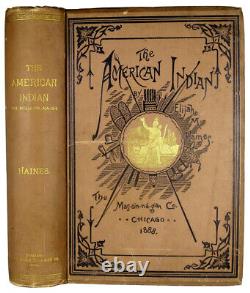
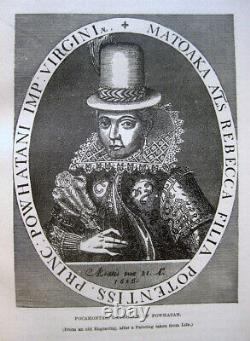
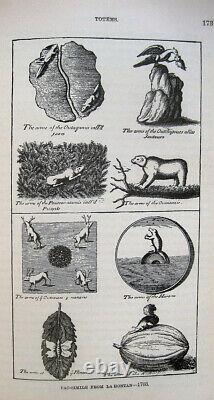
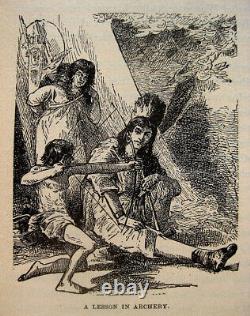
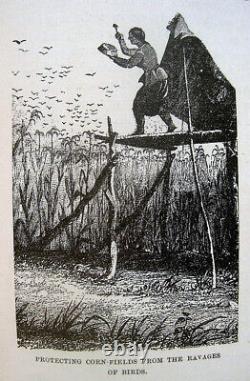
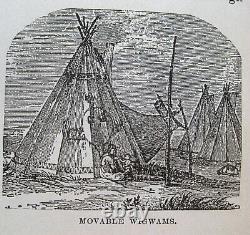
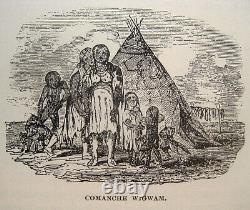
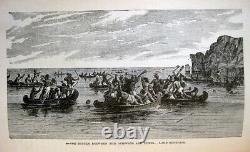
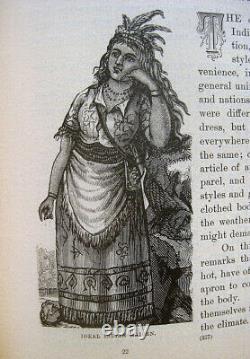
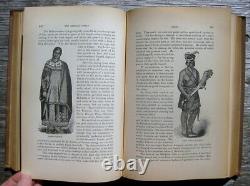
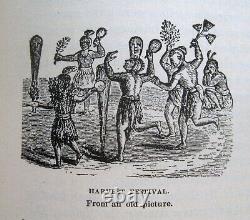
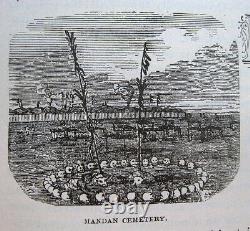
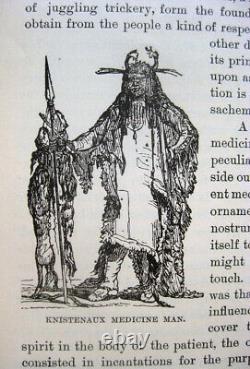
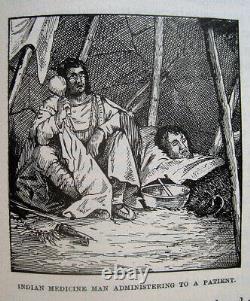
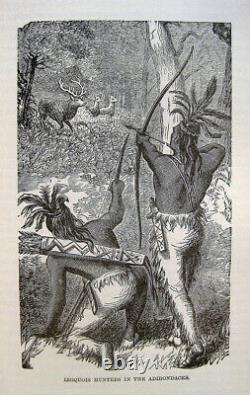
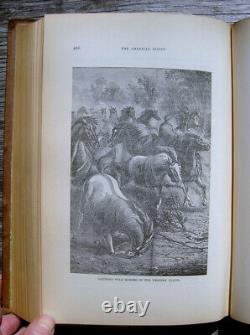
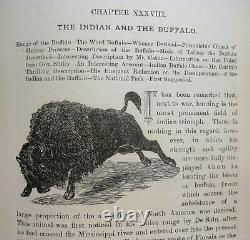

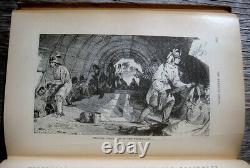
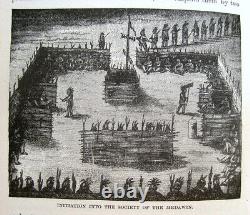
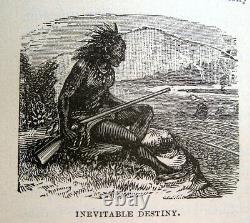
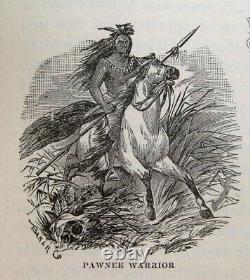
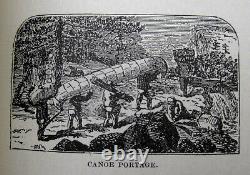



Note: Many of my clients are scholars and historians seeking specific information related to their research. For their convenience I include the following details directly from this book. Subject Matter Featured in this Work (General/Partial Only, Please See Full Contents in Main Description Below): The American Indian Native American Indians Elijah M. "One of the most valuable works ever published in connection with the Indian subject.
The Whole Subject Complete in One Volume. Published in 1888 by the Mas-sin-Na'-Gan Company, Chicago. 10.5" x 7" hardcover.
Illustrated with Numerous Appropriate Engravings. Condition: ILLUSTRATED - VERY GOOD ANTIQUE CONDITION. Exterior as shown in photo. Text is clean and complete.No torn, loose or missing pages. Small blank label inside front cover. A superior example of this extremely rare 19th-century Native American title. THE AMERICAN INDIAN is a very rare late 19th-century illustrated work on Native Americans, written at a time when the great Indian wars were still raging in the far West.
The author's intention was to create a single book that answered every conceivable question about America's original inhabitants. He also addresses the burning issue of the times: what to do with all the Indians whose land white Americans want to steal for themselves, a. A reviewer of the book wrote in 1889. It is a contribution to American literature which future generations will highly prize.
It is rare to rind the Indian question treated so judicially, logically and exhaustively. The ethnologist and historian are both censured for indifference almost criminal in regard to the aborigines of this continent. The government policy of extermination, together with the aggressive warfare and deceptive diplomacy of its agents, is also censured. It is made tolerably clear that the white man was at first hospitably received, generously treated, and liberally rewarded.And it is also shown that the perfidy, treachery and barbarism which now surround the Indian name was originated and fiercely practiced by the white men from Europe. Haines takes the stand that the Indian did not deserve the treatment he has received. He shows that the Indian is not deficient in mental acumen, and cites the Cherokee youth who invented an alphabet as an Illustration.
Haines also contends that the whites are much to blame for the atrocities of the Indian. Author Haines also investigates the origin of the American Indians and even devotes an entire chapter to investigating a popular theory of his day - that Native Americans were descended from the legendary Lost Tribe of Israel. Haines, in his excellent book, devotes two whole chapters to a consideration of the Origin of the American Indians. Everything that seems to have been spoken or written on this subject was examined by the industrious author. He finds the origin of the Indian as much a mystery as the origin of matter itself. There are, it appears, a few writers who contend that the Indian is indigenous to this continent, the same as its flora and fauna. Another school of writers contend that America was peopled from Asia by way of Behring's Straits. Haines also devotes one chapter specially to authorities who maintain that the Indian and Hebrew are from a common parentage.The author himself writes in the Preface. The subject of the American Indian has ever been one of peculiar interest to the ethnologist and student of history; but at no time since the discovery of America has it attracted so much attention as is being given to it at the present day. Volumes upon volumes have been written concerning it in its varied relations, but still it is not exhausted; and indeed the changing circumstances of the American race present at this day a phase of this subject, calling for its renewed presentation in more complete and comprehensive form.
This book has therefore been prepared with reference to this long felt want, and is such a work as the public mind and student of history now seem to demand. As the title indicates, it comprises the whole Indian subject in complete and comprehensive form.In other words, it is a sort of cyclopedia on the subject of the American Indian in all its phases and bearings as shown by the table of contents following; grouping together in condensed form, and within such limited space as the subject will admit of, the varied information comprised in that vast field of research in American history, not to be found in any single work of this kind heretofore published, containing many special features, which are highly interesting and valuable to the general reader. Amongst other special features added, is that of Indian local names in the United States, with their definitions, such as names of states, rivers, cities, towns, mountains and the like, borrowed from the various Indian languages and dialects of the continent, the signification of which has at this day become a matter of interesting inquiry. This is the first attempt ever made to give to the public the signification of Indian geographical names throughout the United States. This feature alone renders it one of the most valuable works ever published in connection with the Indian subject. CHAPTER ONE INTRODUCTORY: "The Proper Study of Mankind is Man" First Reliable Information The Jesuit Missionaries LaHontan, Hennepin and Others Niagara Falls The Long River Capt.
John Smith Pocahontas Sir Walter Raleigh Characteristics of the Indians History at Fault Testimonies of Winslow, Trumbull and Others Later Developments The Race Fast Fading Away The Indian Mentally The Indian and His Country Occupation of Same by the Whites What the Indian Might Have Been His Natural Abilities Progress Prospects. CHAPTER TWO ORIGIN: Speculation of Ethnologists Lost Tribes of Israel Resemblance Between the Indians and People of Asia Language of Northeastern Asia Similar to American Languages Comparison of Words in Indian and Asiatic Languages Wreck of Japanese Junk on Northwest Coast Conclusions Therefrom Similar Customswith the Ancient Jews The Bow and Arrow Like those Found in Asia - The Indian has in all Ages Reproduced Himself Ancient Ruins Ancient Mounds Ancient Pottery Same Made by Modern Tribes Indian Languages Reveal History Testimony of Humbolt Capt. Jonathan Carver Spanish Authorities Tradition of the Mexicans Former Spanish Occupation Opinions of Numerous Authors Uniform Characteristics among the Indian Tribes Intelligence of the Native Indian A Descendant of the Most Ancient Population His Primitive Condition not Evidence to the Contrary. CHAPTER THREE INDIAN TRADITIONS: Oral Traditions Preserving History by Hieroglyphics Belts of Wampum Mode of Transmitting Historical Events Had their Homers and their Aesops Traditions Vague and Shadowy Serve, however, Some Purpose Traditions of a Deluge Traditions of the Origin of their Race The Mandans Traditions of a Flood Representation of the Ark Ceremonies Commemorating the Flood Pottawattamie Tradition Creek Indians Tradition of Their Origin Tradition of the Ojibways Of Their Origin Nanahbozhoo Mysterious Power Origin of Indian Summer Shawnee Tradition Foreign Origin Montezuma Cortez New England Indians Tradition Sauk Indian Tradition Tradition of the Chickasaws Tradition of the Osages Tradition of the Senecas Great Hill People Iroquois Nation Hiawatha Mysterious Power His Miraculous Disappearance Tradition of the Arrapahoes Tradition of the Blackfeet The Bonaoks Their Tradition.
CHAPTER IV AFFINITY WITH THE JEWS: Opinion of James Adair The Indians Descended from the People of Israel He Assigns Twenty-three Arguments for this Opinion Similarity Between the Languages Comparison of Words and Sentences Opinion of Rev. Boudinot Favors this Theory Rev. Ethan Smith Evidence in Favor of this Theory The Indians Acknowledge but One Great Spirit like the Jews Father Charlevoix Presents Evidence in Support of this Theory Indians Were Never Known to Worship Images Evidence of William Penn Features of the Face like the Hebrews And so with Dress, Trinkets and Ornaments Their Fasts and Feasts, like the Jews They Reckon by Moons and Count Time like the Hebrews Have their Prophets Abstain from Unclean Things Neetmok Salute the Dawn of Morning by Devotional Ceremony In their Lodge Tales and Traditions Twelve Brothers are Spoken of Custom in Mourning for the Dead, like the Jews Have a Custom of Burnt Offerings Had a Custom like the Jews of Annointing the Head The Indian Medicine Lodge Corresponded to the Jewish Synagogue Had a Secret Order Resembling that of the Jews Their Medicine Man Corresponded to the "Wise Men, " Matthew II, 1 The Bow and Arrow was Common to the Jews The Indian Tent was like that of the Jews Lived in Tribes like the Jews. CHAPTER FIVE LINGUISTIC GROUPS: Classification of Groups and Tribes Groups Were the Subject of Division into Tribes Had a Location Classified According to Language Groups Designated by this Mode Number of these Groups Excluding the Esquimaux Stock Names of Groups Algonquins, Iroquois, Appalachian, Dakota and Shoshonee Algonquins Most Numerous Groups Composed of Tribes of Same Language Location of Each Group Definitions and Names of Groups. CHAPTER SIX INDIAN TRIBES: Names of Tribes, how Acquired Signification of Names of Various Tribes Location of Tribes Changing Location Extinct Tribes Migration Indian Tribes are Great Families Confederacies for Purposes of Government Union for Purposes of Defense Names of Various Tribes Inhabiting the Original Country of the United States. CHAPTER SEVEN TOTEMS: Signification of Word Totem A Symbolic Designation Origin of Totem Distinguishes the Band A Kind of Coat of Arms Explanation Universal among the Indians Unlawful to Marry in the Same Totem Similar Custom in the Old World. CHAPTER EIGHT GOVERNMENT: Erroneous Opinion of the American Indian as to his Government Same kind of Government Prevailed among All the Tribes Not a Government of Force One of Acquiescence General Uniformity Union of Tribes League of the Iroquois Principles on which a Chief Governs According to Will of the Tribe Councils Organizing and Conducting Chiefs Rank Succession Equality Criminal Code Opinion of Dr.Franklin Caleb Atwater's Description of an Indian Council Authority of Chiefs. CHAPTER NINE INDIAN LANGUAGES: Each Group had a Different Language Each Tribe Spoke the Language of the Group Varying in Dialect among Themselves Indian Languages not a Jargon Rich in Verbs and Grammatical Forms Marked for Method and Regularity Uniformity in Construction over the Continent Language of the Algonquins The Prevailing Language Word Building Grammatical Construction Examples Dakotas Iroquois Cherokee Chinook.
CHAPTER TEN INDIAN SIGN LANGUAGE Sign Language among all the American Tribes One System Universal Most Tribes Understood Each Other Practical Instance Cited Manner of Alluding to the Great Spirit Practical Illustrations Use of Sign Language Interpretation of Sentences Definition of Various Signs Signals Fire Smoke Use of Pony Blanket Illustration. CHAPTER ELEVEN INDIAN CHARACTER: Type of Character Native Characteristics Attachment to his Tribe Integrity and Fidelity Peaceable, Sociable, Obliging and Hospitable among Themselves Opinion of Columbus Love their Neighbors as Themselves Due Respect to the Rights of Others Vices Acquired from the White Man Honorable Character of the Iroquois Opinion of the Novelist Cooper Opinions of Indian Traders The Crow Indians Opinion of Mr. Catlin Testimony of Captain Carver Treatment of Captives. CHAPTER TWELVE PHYSICAL CHARACTERISTICS: Argument for Race Unity Uniformity in Physical Characteristics Influenced by Climate and Surroundings Cranial Structure General Description Complexion Stature Muscular Strength Facial Outline Eyes Teeth Beard, Disputed Point Mixed Blood Utes Choctaws Shawnees Kawas California Indians Shoshonees Hair of the North American Indian.CHAPTER FOURTEEN DANCES: The Institution of Dances Thanksgiving Ceremonial Acceptable to the Great Spirit Taught to Consider it a Divine Art Designed by the Great Spirit for their Pleasure and His Worship A Mode of Social Intercourse Arousing Patriotic Excitement Strengthens Popular Enthusiasm Inspires Indian Youth The Iroquois had Thirty-two Distinct Dances Komteen Different Kinds of Dances among Different Nations and Tribes Sun Dance of the Sioux Declared by Indian Agents Barbarous and Forbidden Comparison with the White Man's Pugilistic Exhibitions Other Barbarous Practices of the White Man. CHAPTER FIFTEEN AMUSEMENTS AND GAMES OF CHANCE: Indians are Fond of Amusement Delight in Games of Chance Ball Playing Game of La Crosse Addicted to Practical Joking Various Modes of Gambling Various Devices for Amusement Game of the Plum Stone Card playing. CHAPTER SIXTEEN FOOD AND SUBSISTENCE: Legend of Indian Corn Facts Concerning Same Uses of Corn Meat and Other Articles No Regular Time for Meals Eat when they are Hungry Mode of Cooking Women do the Work of Cooking Mode of Preserving Meat The Zea Maize Mode, Use and Manner of Cooking Wild Rice Vegetables and Fruits Fondness for Sugar Sugar Making A Grand Indian Carnival Mode of Proceeding in Making Sugar Mokuks, or Birch Bark Boxes. CHAPTER SEVENTEEN MARRIAGE AND DOMESTIC AFFAIRS: Marriage Institution Simplicity of the Marriage Ceremony Observations of Rev. CHAPTER EIGHTEEN PARENTAL AND FILIAL AFFECTION: Unfounded Prejudices against the Indian Redeeming Characteristics in his Parental and Filial Affection Striking Incidents Related A Daughter's Attachment to her Aged Father Pathetic Anecdote A Father's Affection Manifested for his Son Remarkable Instance A Father's Cheerful Death to Follow the Spirit of his Child to the Land of Souls Respect for Old Age Fond of their Children A Mother's Attention.
CHAPTER NINETEEN INDIAN HABITATIONS: Simplicity of the Indian Habitation or Wigwam Term Wigwam, from whence Derived Mode of Constructing Habitations among Different Nations Among the Algonquin Tribes Among Tribes of the Sioux Stock Among the Mandans Among the Indians of the Plains in General Among the Tribes of the Shoshonee Stock Among the Nootkans Among the Tribes of the Iroquois Stock Inside Arrangement and Construction. CHAPTER TWENTY THE INDIAN CANOE: The Word Canoe From whence Derived Among what People First Seen by Europeans How Made Became a Universal Word among the Whites Indispensable to the Indian Used by War Parties Different Styles of Canoes Among Different Tribes and Nations Canoe of the Mandans and Western Tribes Canoes of the Caribbees Bark Canoes Canoes of Light Material for Convenience of Portage Mode of Constructing Canoes Various Sizes Selecting Trees for a Canoe Time of Stripping Bark for Canoe Quotation from Longfellow.CHAPTER TWENTY-ONE WEAPONS AND UTENSILS: Weapons of the Primitive Indian The Bow and Arrow War Club Spear Hatchot Flint Arrow Heads Stone Hatchets Utensils for Various Purposes Flint Knives Graining Tools Awls Fish Spears Nets Implements for Producing Fire Utensils for Cooking Clay Pots. CHAPTER TWENTY-TWO NAMES OF PERSONS: Application of Names to Designate Persons Imitation of Jewish Custom Names have Signification Male and Female Names No Surnames Duplicate Names From whence Names of Persons are Derived Baby Names Naming Children "There is Something in a Name" Custom of the Dakotas Custom in Changing Name Nicknames Objection to Speaking their Own Name Husband and Wife do not Mention Each Other's Names Examples of Indian Names. CHAPTER TWENTY-THREE INDIAN LOCAL NAMES: Indian Names Applied to Localities Popular Idea Signification Classification of Groups in Determining Names Tracing Origin of Names Algonquin Names Prevail Phrases Reduced to One Word Contraction of Words Ignorance of Origin and Meaning Indian Names of States and Territories Names Coming from the French and Other Languages Same Word in Different Languages and Dialects, Differing in Meaning Names Coming Through Illiterate Persons The Word Penobscot Rendered by the French in Sixty Different Ways The Word Calumet Not an Indian Word as Supposed Words of French Orthography Corruption of Indian Names Examples of Corruption of Indian Words Inappropriate Signification of Words. CHAPTER TWENTY-FOUR DRESS: Simplicity in Style Suggestive of Convenience General Uniformity among the Tribes Different Styles Dress According to Weather and Season Description of the Indian Dress Material Skins of Animals Moccasins for the Feet Dress of the Indian Woman Its Convenience According to Notions of Strict Propriety Indians of the Pacific Coast Doherty's description Criticism of the White Man on Fantastic Indian Dress The White Woman's Fantastic Dress Compared The Indian Paints his Face, so Does the White Woman The Indian War Bonnet Not a Fantastic Display, but a Superstitious Notion Buffalo Horns as a Badge of Bravery The Indian Dress is Symbolic, rather than one of Fantastic Display The Indian Dude Indian Dress of the Mountains and the Plains. CHAPTER TWENTY-FIVE RELIGION: Man Naturally a Religious Being A Characteristic Prominent among the Indians Religion Similar to the Jews Belief in One Great Spirit Belief in a Bad Spirit Subordinate Good Spirits Like the Jews they had Fasts and Feasts Observed with Religious Devotion Traditions of the Flood Houses of Worship of Civilized People Indian Medicine Lodge Abiding Faith in a Future Existence Land of the Blessed or Country of Souls The Passage of the Soul to the Everlasting Abode Belief in Difficulties on the Way Belief that the Soul Tarries a Time Near the Body Passage Over a Stream on the Way to the Land of Souls Like the River Styx of the Greeks Perils in Passing Over this Mythical River Description of the Land of the Blessed Indian Religion a Subject of Criticism What the Indian Thinks of the Religion of the White Man The Indian Priest The Indian Highly Devotional Smoking, a Devotional Act Believed in Souls of Animals Belief of the Iroquois.
CHAPTER TWENTY-SIX INDIAN SUPERSTITION: Multitude of Spirits Manifested in Mysterious Ways Omens among the Stars and Clouds Flight of Birds Superstition about the Robin Thunder God of the Ojibways Superstition of the Ojibways Creek Indians had Sacred Plants Buffalo Blood Magic Properties Superstitions of the War Bonnet Large Animals Objects of Superstition White Animals Objects of Worship Large Animals Believed to Possess Powerful Spirits Spiritualism an Old Story among the Dakotas Tendency to Believe Everything is Inhabited by Spirits Legend of a Mythical Bird Singing at Evenings Sacred Character of Fire Dreams Believed in Superstitions of the Indian and the White Man do not Essentially Differ. CHAPTER TWENTY-SEVEN WITCHCRAFT: Pagan Character of the Indian Marked by His Belief in Witchcraft The Civilized White Man and Pagan Indian Compared in this Regard The Indian's Fear of Supernatural Agencies Belief in Witchcraft was Universal Effect upon their Prosperity and Population Among the Iroquois League Wizards, a Secret Association Meeting at Night Tradition among the Onondagas Indian Pow-wows Conjurers and Medicine Men Witches- Wizards Their Powers and Characteristics Witches in the Shape of Animals The Puritan Idea of Witches Ignorance Charged upon the Indian for his Belief in Witches Reference to the Learned Sir Mathew Hale Who Tried and Convicted Two Old Women for the Crime of Being Witches. CHAPTER TWENTY-EIGHT FASTS AND FEASTS: The American Tribes had a Custom of Fasts and Feasts Custom of Fasts Not Frequent Custom of Feasts Quite Frequent Feasts a Favorite Source of Excitement Different Kinds of Feasts among Different Nations Feasts of the White Dog Universal General Resemblance of Feasts among All The Man who Gave Many Feasts a Great Favorite with his Tribe Feasts among the Ojibways Medicine Feast Feasts for Dreams Feast of Giving Names War Feast The Great Feast Wabeno Feast Feast for the Dead Feast for His Medicine Boys' Feast Regular Feasts of the Iroquois Maple Feast Planting Festival Strawberry Festival Green Corn Festival Harvest Festival New Year's Festival Fasts Strictly a Religious Custom. CHAPTER TWENTY-NINE DEATH AND ITS INCIDENTS: Coincidences with Nations of the Old World No Fear of Death Ceremonies Much Like the Jews Relatives of the Deceased put on Coarse Garments Women as Hired Mourners. Offering Made During Time of Mourning Ojibways Custom Attended with Much Interest Offering Food to the Dead Cremation among Some Tribes Instance Related Mourning Cradle of Child Custom Never to Mention Name of the Deceased Bury Body East and West Reasons Therefor No Enduring Monuments. CHAPTER THIRTY MEDICINE MEN: Term Medicine Three Distinct Professions The Doctor of Medicine The Magician The Prophet Popular Idea Dress Medicine Bag Its Contents Its Construction Claims of Supernatural Influence Animal Magnetism Trials of Power A Remarkable Instance Prophetic Gifts Mental Telegraphy Holy Garments Robes of Mystery Robes of State Judicial Ermine Observances in Regard to Medicine Men In Regard to Smoking Tetotalism and Chastity of Women. CHAPTER THIRTY-ONE INDIAN PROPHECIES: The Indian Prophet An Important Functionary As with the Ancient Jews Was the Oracle of "All Mystery" False Prophets Chiefs had Their Prophets Foretelling Events Remarkable Instance Related Capt.Carver Relates an Instance Account from an Indian Captive Singular Instance of Foretelling the Future Fulfilled in the Escape of Three Captives Father Charlevoix's Experience Peter Jones Gives Instance of Indian Prophecy. CHAPTER THIRTY-TWO ANATOMY AND MEDICAL KNOWLEDGE: Knowledge, how Acquired Comparison of the Indian and the White Man Knowledge of the Functional Organs of the Body Which Their Language Indicates Their Knowledge Comparative Pathology Want of Knowledge through Scientific Experiments Limited Knowledge of Circulation of the Blood Knowledge Derived from the Whites Incantations By Sacrificial Rites Pretentions of Indian Knowledge Compared with the Pretentions of the Medical White Man Originally, Indians had but Few Diseases Causes of Diseases Simplicity of Diet Administer Simple Remedies Sacrifices to Propitiate Spirits A Practice Like the Jews Fracture or Breaking of a Bone Understand Nature of Poisonous Plants Knew Nothing of Paralysis Ideas of Blood Letting. CHAPTER THIRTY-THREE DISEASES AND TREATMENT OF THE SICK: Originally but Two Fatal Diseases among Them Consumption Destroyed Many in Later Times "The Indian Student's Lament" Diseases among the Ojibways What La Hontan Says of Diseases among the Indians Small pox Very Fatal Indian Ideas of Sickness Fear Pain and Long Duration of Illness More than Death Physician or Doctor of Medicine Various Remedies Sweat Lodge Manner of Constructing Vapor Baths not a Matter of Luxury Chickasaws Doctor Attending the Sick.
CHAPTER THIRTY-FOUR ASTRONOMICAL AND GEOGRAPHICAL KNOWLEDGE: Knowledge from Observation North Star Star that Never Moves Guides Them by Night Solar Walk or Milky Way Indian Opinion Coincidence with Ancient Belief of the White Man Have Names for Particular Stars Seven Stars The Great Bear Pleiades Do not Pretend to More Knowledge than They Possess Stars for Which They Have Names Comets Superstitious Belief Eclipses Indian Theory Earthquakes Moving of a Great Tortoise Knowledge of Geography Draw Maps Correctly Course of Streams. CHAPTER THIRTY-FIVE MODE OF COMPUTING TIME: Intuitive Mode of Reckoning Time Cardinal Divisions Days and Months Reckon Days by Suns Months by Moons Four Fixed Points in the Day Rising and Setting of the Sun Noon and Night Some Idea of a Solar Year Spring Summer Autumn Winter Year Begins With Spring Putting Out of the Leaves - Planting Season Reckon Ages by Winters Commemorate Events No Division of Days into Hours Recall Time of Year by Past Events How Mothers Keep Ages of Children Took no Note of Time Names for Different Moons Names of the Four Seasons Lost Moon Examples of Names of Moons among Different Tribes.
CHAPTER THIRTY-SIX NUMERALS AND USE OF NUMBERS: Perfect System of Counting Uniform Decimal System Why Decimal System was Adopted Use of Sticks and Other Objects in Counting Explanation of Mode of Counting Mode among Different Tribes List of Indian Numerals among Various Tribes. CHAPTER THIRTY-SEVEN HUNTING AND FISHING: North American Indians Excel in Hunting Superstition Use of Charms Diligence Snow Shoe Region Thanks to the Great Spirit The Buffalo The Beaver Habits of the Beaver Beaver Dams Beaver Houses Mode of Taking Beavers Hunting the Bear Singular Custom Longfellow's Description The Dog His Faithfulness The Horse Origin among the Indians Comanches Excel in Horsemanship Mode of Capturing the Wild Horse General Hunt Hunting Deer Traps Prairie Fires Seasons for Hunting Assistance of the Women Iroquois Dakotas Fishing Mode of Taking Fish Iroquois are Expert Fishermen. CHAPTER THIRTY-EIGHT THE INDIAN AND THE BUFFALO: Range of the Buffalo The Word Buffalo Whence Derived Formidable Object of Hunter Prowess Description of the Buffalo Mode of Taking the Buffalo Described Interesting Description by Mr.
Catlin Information on this Point From Gov. Sibley An Interesting Account Indian Buffalo Chase Mr.Catlin's Thrilling Description His Eloquent Reflection on the Disappearance of the Indian and the Buffalo The National Park First Suggested. CHAPTER THIRTY-NINE PICTURE WRITING: Original Mode of Suggesting Thought Picture Writing among the American Tribes In Practice as among Ancient People of the Old World Material Used for Picture Writing Characters Engraved on Rocks and Stones The Piasa Man Devouring Bird Description by Marquette Description by Prof. John Russell Picture Writing on Robes Pipe Stone Quarry Instance Noted by Jonathan Carver Illustration from La Hontan System of Picture Writing The Primitive Mind Anecdote of President Lincoln's Father Description Quoted From Longfellow Dighton Rock Rocks at Kelley's Island Caricatures Indian Idea Anecdote of the Shawnee Indian and White Man. CHAPTER FORTY THE PIPE OF PEACE: Generally Called Calumet Not an Indian Word Not Strictly an Appropriate Term A Norman French Word Its Signification Description of the Pipe of Peace Its Sacred Character Other Classes of Pipes Mode of Use Notices by the Early French Secured Them a Friendly Reception Custom of Smoking Mysterious Seal of Religion Custom the Same among all the Tribes Ceremonies of Smoking Mode of Making Peace A Symbol in Ratification of Treaties Tobacco a Gift of the Great Spirit From Stone of the Pipe Stone Quarry Legend of this Mysterious Quarry Description from Longfellow. CHAPTER FORTY-TWO INDIAN ELOQUENCE: Indian Eloquence a Native Talent Not Acquired by Book Education Retort of Red Jacket "I was Born an Orator" Power of Indian Eloquence Indian Eloquence Superior to the White Man Similes and Metaphors Drawn from Nature Speech of the Indian Chief Logan Elements of Indian Eloquence Indian Ideas Gathered from Surroundings The Tempests The Woods The Waterfalls The Sky Injustice to the Indian Languages Adapted to Eloquent Expressions Enthusiastic Description by Caleb Atwater His Experience Indian Eloquence in Council No Violent Gesticulations No Overwrought Enthusiasm The Voice is Loud, Clear, Distinct and Commanding Exalted Opinion from a Public Journalist Some of the Great Indian Orators Enumerated Speech of Capt.
Pipe, a Delaware Chief, at Detroit, in 1801 Speech of Grangula, the Iroquois Chief As Reported by La Hontan Examples of Indian Eloquence. CHAPTER FORTY-THREE INDIAN METAPHORS: Indians are Fond of Metaphors Were Like Ornaments to their Person Powerful Similes Drawn from Nature Added a Charm to their Speeches Appropriated by English Writers Metaphorical Expressions in Common Use Borrowed from the Indians-"Rivers Run With Blood" "To Bury the Hatchet" " You Keep Me in the Dark " " Singing Birds " " I Will Place You Under My Wings" "Suffer no Grass to Grow on the War Path" Are of Indian Origin Examples of Indian Metaphorical Expressions.
CHAPTER FORTY-FOUR INDIAN MUSIC AND POETRY: Origin of Music Vocal and Instrumental Indians are Naturally Musicians Sing on Devotional Occasions Like the White Man Songs of Praise to Deity Like the Jews Songs Consisted of Few Words Short Phrases Many Times Repeated Language of Excitement Expression of Compassion Absence of Measure or Rhyme Voices Often Fine Words Preserved by Picture Writing Indian Music Noted for its Simplicity Scale of Music Limited The Chorus in High Strain of Voice Have Various Instruments of Music Some Instruments Like those of the White Man The Drum Gourd Shell Rattling Sounds Description of Indian Implements of Music Longfellow's Hiawatha an Imitation of Indian Poetry White Man's Old Fashioned Songs Robert Kidd Coincidence with Indian Songs Samples of Indian Music Dog Dance of the Dakotas and others. CHAPTER FORTY-FIVE SECRET SOCIETIES: Two Institutions among the North American Indians From the Atlantic to the Pacific From the Gulf of Mexico to the Arctic Ocean Medawin Jeesukawin Art of Medical Magic Mystery Prophecy Ancient Origin The Term Meda Necromantic Influences Exerted in Secret Medawininne, a Magician Medawin, the Art of Magic Formed into Societies or Associations Admitting Candidates Who May be Admitted Ceremony of Admission Art of Prophecy Ceremonies of the Wabeno Medawin, Definition. CHAPTER FORTY-SIX INDIAN TREATIES: Popular Idea of an Indian Treaty The Notion of the Spanish Invaders The English Idea The Puritans Treaty with Massasoit William Penn Treaties of United States At Fort Pitt Greenville Chicago Prairie du Chien Broken Covenants Proverbial Deception Black Hawk War.CHAPTER FORTY-SEVEN STATUS OF THE INDIAN: The Position the Indian Occupies The Object of the Spaniards Right of Discovery Early Colonists Idea of Eliot Recognition by United States Government Chief Justice Taney's View "State of Pupilage" Winnebago Indians Ponca Indians The Negro Race as Compared with the Indian The Conclusion. CHAPTER FORTY-EIGHT INDIAN BIOGRAPHY: How Indians Attained Prominence among their People Civil and Military Affairs in Separate Departments Illustrious Men Road to Fame Open to All The Word Sachem Prominent Indians Since the Settlement of the Continent Brief Biography of Noted Chiefs. CHAPTER FORTY-NINE ELIOT'S INDIAN BIBLE: Remarkable Literary Production Consisted of the Old and New Testament Translated into the New England Dialects Indians under Religious Instructions at Martha's Vineyard -" Praying Indians " Number Curious Circumstances Leading to Conversion of Indians Questions Asked by Indians Concerning Eliot's Religious Teachings Difficulties He Encountered in Translating Death of Eliot. CHAPTER FIFTY INDIAN CIVILIZATION: Reduced Possessions Insignificant Proportions The Indian Question Preliminary Agencies to Civilization Extinction, or Civilization What is Civilization A Matter of Opinion Various Forms of Civilization The European Form Which the Indian is Expected to Adopt Work of the Puritans Rev.
John Eliot in New England Missionary Work Civilizing Influence of Whiskey Discordant Examples of Puritans Distrust of the White Man's Religion Extermination of the New England Tribes Example of the Brothertowns The Iroquois Six Nations Their Progress in Our Civilization Influence of William Penn Good Work of Quakers Agricultural Instruction The Five Civilized Tribes of the Indian Territory To Become Civilized the Indian Must Become a White Man The Indian Disappearing by Amalgamation Reports of Indian Agents to that Effect The Indian Problem The White Man Problem. CHAPTER FIFTY-ONE INDIAN POPULATION: Population Overrated Exaggerations of the Early Explorers Report of the Commissioner of Indian Affairs Number of Indians in the United States at the Present Time Effect of Contagious Diseases Destruction of Game Semi-State of Starvation Gradual Decrease Cause of Decrease Becoming Removed How Indian Population Became Overestimated Exaggeration of Population in New England The Iroquois Nation Exaggeration of Numbers The West Indies Numbers Overestimated And so in Virginia How a Small Number of Indians Appear Large Indians of Kentucky No Permanent Indians there. CHAPTER FIFTY-THREE WARS AND MASSACRES: Prejudice of White Man Want of Correct Information History Misunderstood and Exaggerated Methods of Declaring War On the Warpath Their Encampments Engagements Prisoners Running the Gauntlet Adoption of Prisoners Spanish Invaders Committed First Murder Outrages by DeSoto and D'Allyon Indians Retaliate Attack and Bloodshed in New England by the Whites Fear and Suspicion Aroused among the Indians Indian Attachment to Their Lands Their Efforts to Retain Them Indians Aroused by the British Against the Colonists Indian Massacres Stimulated and Led on by the Whites One Faction against the Other The So-Called Wyoming Massacre True History of the Same Burning of Joan of Arc Other Instances of Man's Inhumanity to Man History Misunderstood. CHAPTER FIFTY-FIVE VOCABULARIES: Indian Dialects Ojibway Dakota Comanche Miami Menominee Shawnee Oneida Onondaga Blackf eet Tnscarora Mohawk Cayuga Muscogee Zuni Delaware Mandan Arapahoe Sheyenne Osage Nootkian Comparison of Dialects Comparison of Pronouns Words and Phrases Catalogue of Trees and Plants Catalogue of Animals. CHAPTER FIFTY-SIX INDIAN GEOGRAPHICAL NAMES: Definition of Indian Local Names Names of States Counties Cities Towns Rivers Streams Lakes Mountains Ranges.Remember folks, this is an 1888 First Edition. This book is 135 years old. Please be sure to add me to your List of Favorite Sellers.
Don't miss out on any of my latest listings. When you prepare your listings you generally should use only material text, photographs, etc. And trademarks/names that you created or own yourself or licensed from the owners. Item description text; lists of contents, lists of illustrations/photos; scanned images, etc. UNAUTHORIZED USE OF ITEM DESCRIPTION TEXT INCLUDING SUMMARIES OF CONTENTS, ILLUSTRATIONS, ETC. This item is in the category "Books & Magazines\Antiquarian & Collectible". The seller is "neetmok" and is located in this country: US.This item can be shipped to United States, Canada, United Kingdom, Denmark, Romania, Slovakia, Bulgaria, Czech Republic, Finland, Hungary, Latvia, Lithuania, Malta, Estonia, Australia, Greece, Portugal, Cyprus, Slovenia, Japan, China, Sweden, South Korea, Indonesia, Taiwan, South Africa, Thailand, Belgium, France, Hong Kong, Ireland, Netherlands, Poland, Spain, Italy, Germany, Austria, Bahamas, Israel, Mexico, New Zealand, Singapore, Switzerland, Norway, Saudi Arabia, United Arab Emirates, Qatar, Kuwait, Bahrain, Republic of Croatia, Malaysia, Brazil, Chile, Colombia, Costa Rica, Panama, Trinidad and Tobago, Guatemala, Honduras, Jamaica, Barbados, Bangladesh, Bermuda, Brunei Darussalam, Bolivia, Ecuador, Egypt, French Guiana, Guernsey, Gibraltar, Guadeloupe, Iceland, Jersey, Jordan, Cambodia, Cayman Islands, Liechtenstein, Sri Lanka, Luxembourg, Monaco, Macau, Martinique, Maldives, Nicaragua, Oman, Peru, Pakistan, Paraguay, Reunion, Vietnam.
- Binding: Hardcover
- Place of Publication: Chicago
- Language: English
- Special Attributes: 1st Edition, Illustrated
- Author: Haines
- Region: North America
- Publisher: Mas-sin-Na’-Gan Company
- Topic: Native American Indians
- Country/Region of Manufacture: United States
- Subject: History
- Original/Facsimile: Original
- Year Printed: 1888

